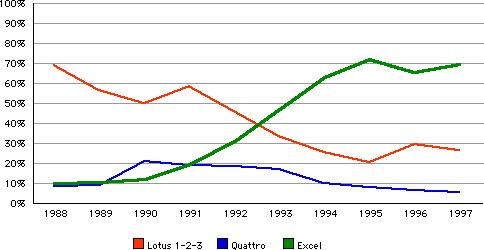The first commercially successful spreadsheets and CAD programs were developed for macs. MS stole ideas and programming from everyone, out marketed and crushed competitors.
Actually, you are way off here.
The first successful spreadsheet was VisiCalc, and it was the "Killer App" that helped the Apple II enter the mainstream for business use in 1979. Over 5 years before the Mac came out (and over 3 years before the Lisa). And for the first year it was an "Apple Only" program, before it was finally ported to other systems like the IBM, TRS-80, and others. And by then it had competition. Most notably from Lotus 1-2-3.
The same with CAD. HP for decades before the MAC came out made a name for itself in the Engineering industry for it's CAD workstations (Unigrafix). Oh yes, these machines did a great many things also (and ran a variant of UNIX as their OS), but in the engineering world they were seen as CAD stations. In the late 1990's I even worked for an architectural company that still had 2 of them in the back office. They were no longer used, but every month or so either the owner or the "old guy" (who had been working as an engineer since the 1960's) would fire it up and print off some of the old work they had done on it, often for a building they had made back in the day that needed remodeling.
Then then took that print-off and handed it off to me to be scanned and updated into AutoCAD.
But the first "big" CAD software was CATIA, which like Unigrafix predates the Mac by almost a decade.
As far as Microsoft "stealing" ideas, everybody did that. Do you think Apple invented the GUI interface? Heck no, they got the idea from the same place Microsoft did. From Xerox PARC.
VisiCalc did not even invent the electronic spreadsheet, they simply streamlined it. And Lotus 1-2-3 did it even better.
And for Office, even that is not new. Most do not remember that in those early days, there were very few "Office Suites", and they generally sucked.
Generally you used either WordPerfect or WordStar for documents, dBase for database work, and Lotus 1-2-3 for spreadsheets. And this was very expensive, generally costing over $1,000 for all 3 of these programs. Then you had companies like Enable, which made one of the first "All-In-One" office programs. And oh yes, I remember this piece of trash all to well.
In the early days of desktop computers in the Military, we all piggybacked on an Air Force contract of the mid-1980's. It was a Zenith 286, that came with an EGA monitor, an Alps P2000 printer, and a software suite that included MS-DOS 3.3, Windows 1.03R, and WordStar. And from around 1984 until around 1990 this was the system most in the military used. But in around 1990 the Marine Corps decided that they were going to cut costs, and got a site license for the Enable Suite, and decided that would be the "Marine Standard" for word processing, spreadsheets, and the rest.
And needless to say, it was largely ignored. Yes, it did word processing, spreadsheets, and databases. But the software all pretty much sucked the big one. So we just agreed and sent memos to confirm our compliance to the new order, and continued to use WordStar and Lotus. And things stayed that way pretty much until most companies migrated to Windows. That move, the fact that Microsoft already had a decent office suite for the platform, and that nobody else had an office suite worth a damn for Windows at the time pretty much crushed the competition.
One thing that MS was always good at, was in predicting trends. In the early days of the "GUI Wars", you generally had a GUI that had 1 or maybe 2 "killer apps", and really nothing else worth bothering with. They had very obtuse and hard to work with requirements (often including backwards licensing fees) for anybody else that wanted to work with them, and by and large they died. MS on the other hand pretty much gave away their development kits. And they did not mandate any kind of fees or certification process for somebody writing for their platform, only if somebody wanted the "MS Certified" logo (which was not very expensive, was a 1 time fee, and entirely optional).





